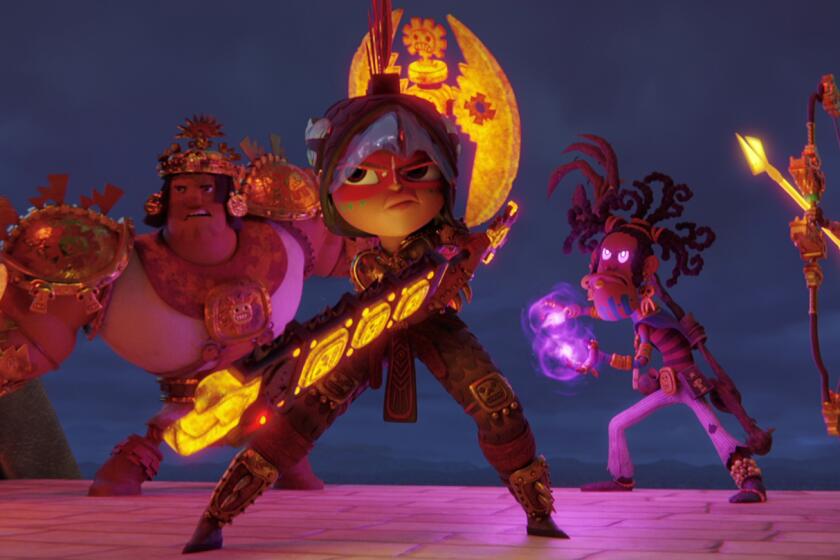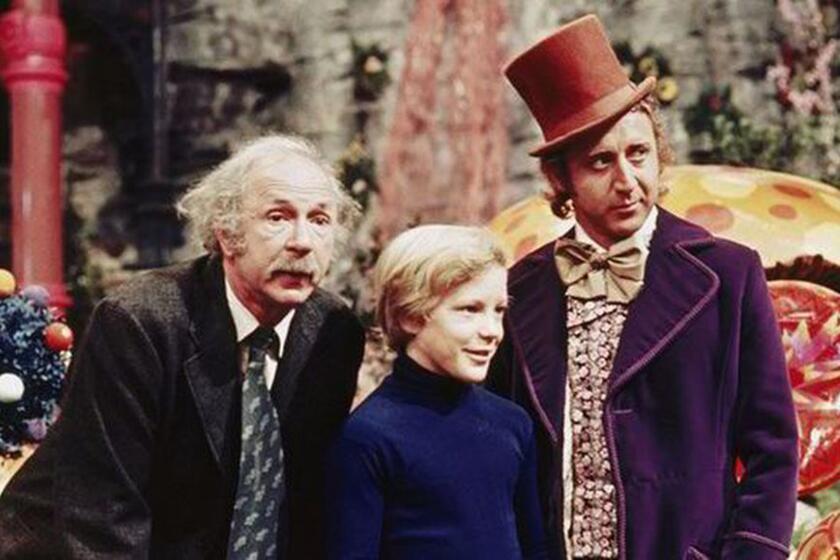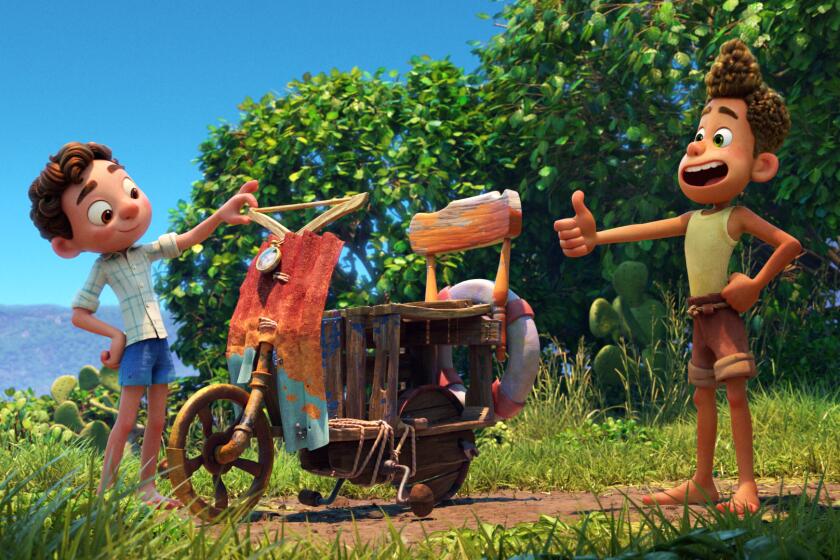The Indigenous influences on Netflix’s ‘Maya and the Three,’ explained
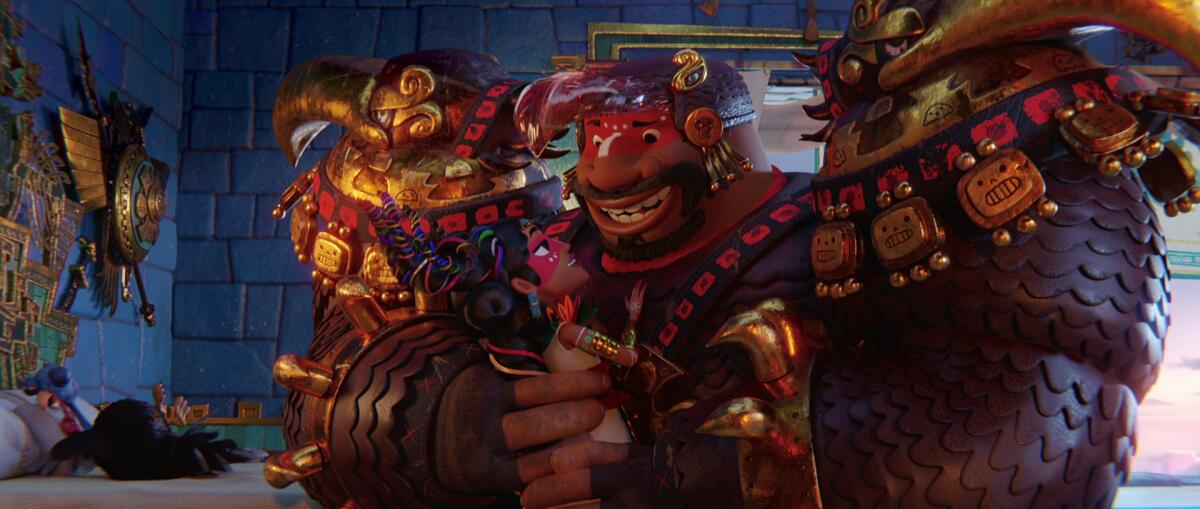
- Share via
Densely rich with mythology, formulated from a cornucopia of timeless and relatively recent sources, “Maya and the Three” is an animated magnum opus of superlative imagination, detailed craftsmanship, thrilling action and thoughtful, earned pathos set amid a whimsically breathtaking reimagining of Mesoamerica in antiquity.
Behind this nine-chapter miniseries debuting on Netflix today is Mexican-raised, U.S.-based virtuoso director Jorge Gutiérrez and his close collaborator and wife, Sandra Equihua. Together they previously executed their take on superheroes in the Nickelodeon show “El Tigre” and their fanciful rendering of the Day of the Dead via the Golden Globe-nominated animated feature “The Book of Life.” Now, with “Maya,” they’ve built a temple to the foundational civilizations of Latin America that is at once endearing and dazzling.
“As Mexicans, we kind of put the ancient world so far behind us that you disconnect,” said Gutiérrez about the significance of reigniting interest in the past by realizing Indigenous people are part of our present. Though “Maya” deliberately doesn’t use the words Aztec, Mayan or Incan in order to maintain a certain distance between this magical fiction and fact, the art and ideologies of those cultures acted as the couple’s prime creative resource.
Part of their undertaking was to peruse how these brilliant and advanced societies had been represented in media before. In animation, the most widely seen examples were DreamWorks’ “The Road to El Dorado” and Disney’s “The Emperor’s New Groove” — both films where cultural aspects are “just there as an Epcot background version of it,” as Gutiérrez put it.
Over its 270-minute running time, the highly ambitious “Maya and the Three” follows a fierce teenager from Teca Kingdom destined to become an eagle warrior. Maya (Zoe Saldaña), the daughter of King and Queen Teca (lovingly voiced by Gutiérrez and Equihua, respectively), is tasked with upholding a prophecy to defeat Lord Mictlan (Alfred Molina), the ruler of the underworld who wants to sacrifice her. Traveling across the neighboring lands, she must enlist a team of warriors. Epic confrontations ensue.
“I finally get the breathing room. I finally get to tell all the backstories. No studio would let me make a four-and-a-half-hour movie, especially animated,” said Gutiérrez. “I’ve never felt more liberated than with this new format. As a storyteller, I got to tell the whole thing for good — but also for bad, by the way, because it was a lot of work.”
For Equihua, a pivotal aspect of updating the legends is to combat the misogyny inherent to them in their original readings by making the protagonist a punk rebel princess, prominently featuring strong goddesses or making the sun a feminine source of life. “I hope that a little Latina girl out there decides to become an animation director and take the helm, or become creator, a designer, a writer,” Equihua said. “That she sees she has the power to do what she wants, because we need more Latinas in the arts.”
Gutiérrez’s parents recently watched “Maya” in full and were moved to tears because, underneath the rousing adventure, the emotional heft of the familial bonds soar.
“Maya is our girl, right. She’s our daughter. We saw her grow up from being a baby, and now she’s going out into the world, and we hope the world is kind to her because she’s a good person,” Gutiérrez said. “More than anything, we poured our hearts and soul into her story. We hope it connects with the world, and if people can’t come to Mexico or to Latin America, don’t worry, they’re coming to visit you.”
Below, we take a deep dive into Gutiérrez and Equihua’s enormous compendium of influences.
Architecture of Teca Kingdom
Growing up in Mexico City, where urban landscapes coexist with ancient edifices, Gutiérrez had access to the National Museum of Anthropology, which houses a vast collection of pre-Columbian artifacts, as well as the Templo Mayor, ruins of an Aztec temple near the metropolis’ main square. “They had these maquettes with characters in them,” he recalled about his childhood visits. “As a lover of action figures and toys, I thought, ‘These are the greatest toy sets of all time!’” While preparing “Maya,” he and Equihua returned to these sites on multiple occasions to industriously document the iconography and architectural designs of Mesoamerican civilizations, with an emphasis on the Aztecs (Teca comes from “Azteca”).
“Early on, Teca looked too serious, too archaeological. We had let the research guide the aesthetic too much, and it looked like we were showing off the research,” he explained. Backpedaling, the creators realized that, just as artists Jorge González Camarena or Frida Kahlo had painted their takes on the region, this could be their fantastical, animated interpretation and not a work of historical accuracy. Motifs from other cultures also influenced major architectonic elements in the series, namely the Divine Gate (from the enigmatic Olmecs) and the Pantheon of the Gods (inspired by the Mayans).
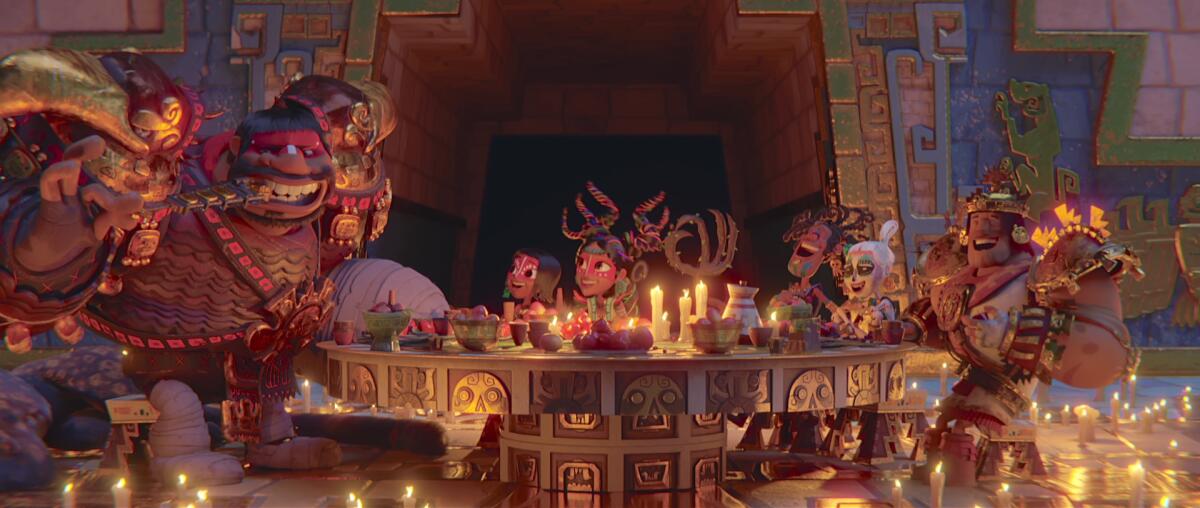
Physical Proportions
Pronounced and varied, the bodily proportions of their characters reflect Gutiérrez and Equihua’s approach across their body of work, which was reinforced by their in-depth observation of ancient sculptures depicting people not realistically but with intent. For them, this also debunks the implication that the past was solemn and stoic. “These are artists of the time reinterpreting what they were seeing,” said Gutiérrez. “We were getting to see character designs from 500 years ago. Then you start to realize some of these are really humorous.”
In analyzing these relics, the creative partners were amused at how the makers handled feathers, how humanoid figures with large bodies featured small legs, or how those with sizable heads had tiny eyes. Mimicking those exaggerated physical traits in their project imprinted idiosyncratic style into a technique that tends to render out distinctiveness. “As children, you play with your toys, and what stop-motion animation does is it fulfills that fantasy. Every kid who draws imagines their drawings moving. When you see 2D animation come to life, it connects to that childhood wish,” he added. “CG animation is a lot colder, so we have to put so much more effort to make that magic feel real.”
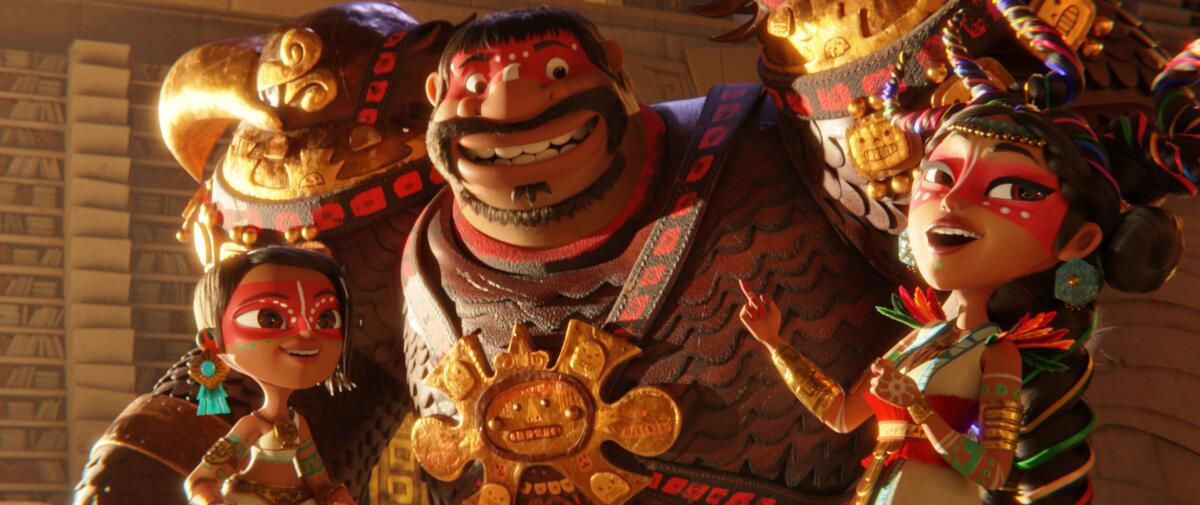
Ornamental Costume Design
Minimalism-averse, Gutiérrez adores ornamentation, as the intricate armors and costumes showcased in “Maya” can attest. His baroque-oriented aesthetic finds balance in Equihua’s clean and more shape-based designs. She refers to Gutiérrez’s workspace as the aftermath of a piñata explosion. His elaborate vision resembled graphically complex Aztec and Mayan glyphs. “A lot of people on the crew would look at the designs and go, ‘How’s that going to move?’ And I would go, ‘Look at the reference, look at the source, if anything, we’ve simplified it for you,’” he said. At times, not even Equihua could envision how his ornate imagination would function on screen.
Character designers at heart, the two of them also conceived the world around the characters, which is not always the case in animation. “Sandra keeps saying, ‘The only reason you became a director is so you could design a million characters.’ It’s true, she’s right,” Gutiérrez said candidly. Equihua, whose family is of Purépecha descent from the state of Michoacán, dipped into her heritage for inspiration. When she was 5, her parents were so enamored with their culture that her birthday party was an homage to it. Everyone in attendance wore traditional attire and ribbons in their hair. These ribbons made their way to “Maya” via the Queen Teca and Ah Puch (voiced by Rita Moreno).
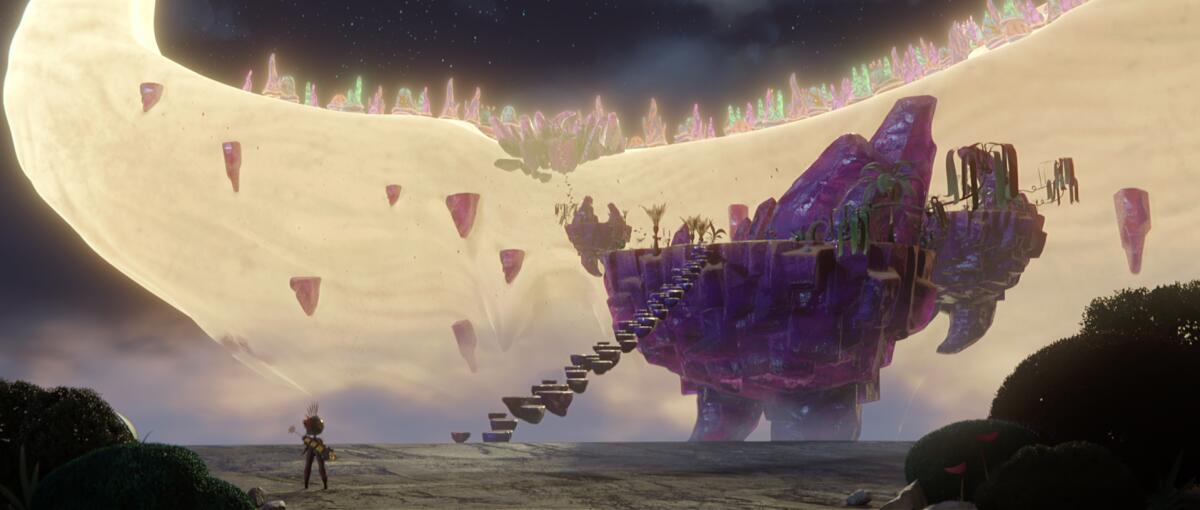
Luna Island and Afro-Caribbeans
To honor the contributions of Black Latinos, more concretely Afro-Caribbeans, Gutiérrez invented Luna Island, the home of honorable sorcerers located among the stars. For this segment of the storyline, our guide is Rico (voiced by Allen Maldonado), a talented young wizard who, like the other main characters, has overcome tragedy. “My favorite painter is [Jean-Michel] Basquiat, the son of a Puerto Rican mother and Haitian dad. Rico is Basquiat, who at some point was homeless and went on to be the most highly valued U.S. painter in history. The design and the way Rico is dressed is a love letter to Basquiat. That’s me giving my love to the Caribbean and everything that they’ve given us,” he said.
Since Rico is a character with a stutter, the production hired a stuttering consultant. “In a lot of stories, one overcomes a disability and then becomes better, and that’s not cool because it implies that there’s something wrong with you. So it became very important with Rico to go, ‘No, stuttering is part of who he is, and in fact, stuttering makes him a better wizard,’” explained Gutiérrez. “That’s very much reflective of what happened to me as a person on the autism spectrum. Early on, people were like, ‘Don’t worry, we’ll fix you.’ And I thought, ‘No, the thing that you think is bad is actually the thing that makes me really unique.’”
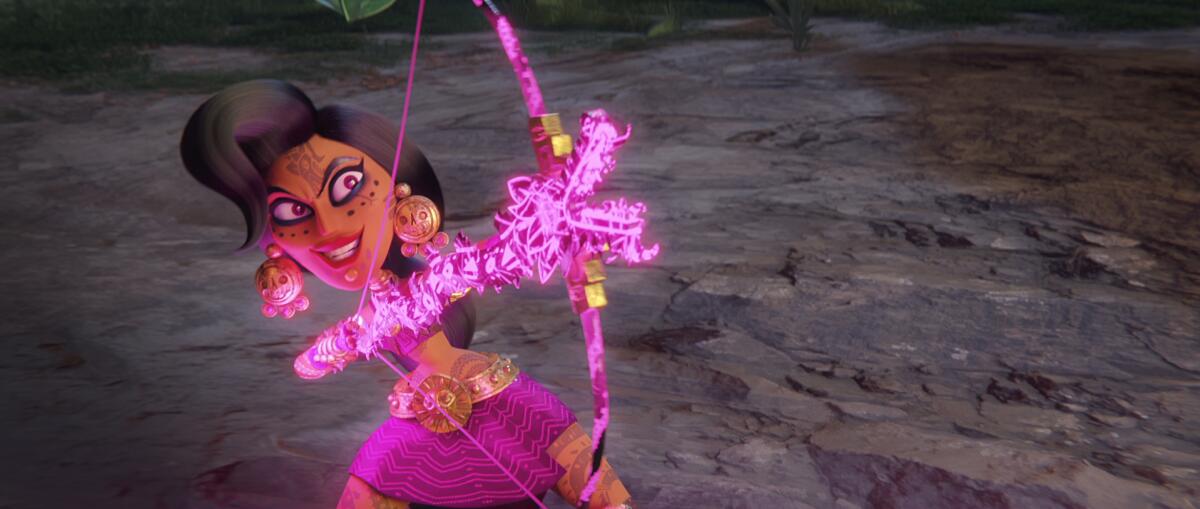
An Array of Deities
The powerful antagonists — and a few allies — along Maya’s divine quest are Gutiérrez and Equihua’s reinventions of both Aztec and Mayan deities. With over 500 gods to choose from, they drafted those that spoke to the innermost weaknesses and strengths of the human characters. They preserved their names and attributions, while liberally conceptualizing their look. Centuries ago, the Spaniards destroyed most of the ancestral manuscripts that could have provided more precise visual references of how Indigenous people saw these beings, with a few exceptions, such as the Codex Borgia. “Acat, the tattoo goddess, had to express what would happen to Maya if she embraced her dark side. Cabracan and Cipactli, voiced by Danny Trejo and Rosie Perez, are luchador gods that speak to what would happen if her parents were not diplomats and just embraced fighting. All of these have to be reflections of Maya’s family,” said Gutiérrez.
As the story unfurls, the gods also appear as evil reflections of the shortcomings in the heroine’s companions: Rico, Chimi and Picchu. Ultimately, these powerful entities exist to elucidate the human condition and our relationship with forces beyond our control, ideas to which Gutiérrez applies his own philosophy. “In all my favorite mythologies, the gods obviously think they’re smarter than the humans, and then the humans teach them the lesson,” said Gutiérrez. “To me, that’s a metaphor for kids teaching their parents a lesson.”
The Jungle Land and Death
Early on during the world building, the duo decided that the Jungle Land in the show would take after Mayan culture (in southern Mexico and Central America) and its marked veneration of death. For Gutiérrez, this connected to his belief that Mexicans enjoy a special relationship with the process of departing this mortal plane, somewhere between profound respect and irreverence. “Mexicans have death in the ear whispering to us, ‘Live!’ And so this world basically acknowledges, ‘Yeah, there’s death and that’s what gives life value,’” the director noted. “You can’t have one without the other.”
Skulls saturate the design of this realm. They are in every structure, in the jewelry, in nearly every object and even painted on the faces of its inhabitants. Chimi (Stephanie Beatriz), the warrior from this land that joins Maya, shuns humanity for its transgressions and embraces a morbid fascination with meeting Lady Micte (Kate del Castillo), queen of the underworld. Thematically, Gutiérrez aimed to exhibit that her obsession with death prevents her from feeling alive.
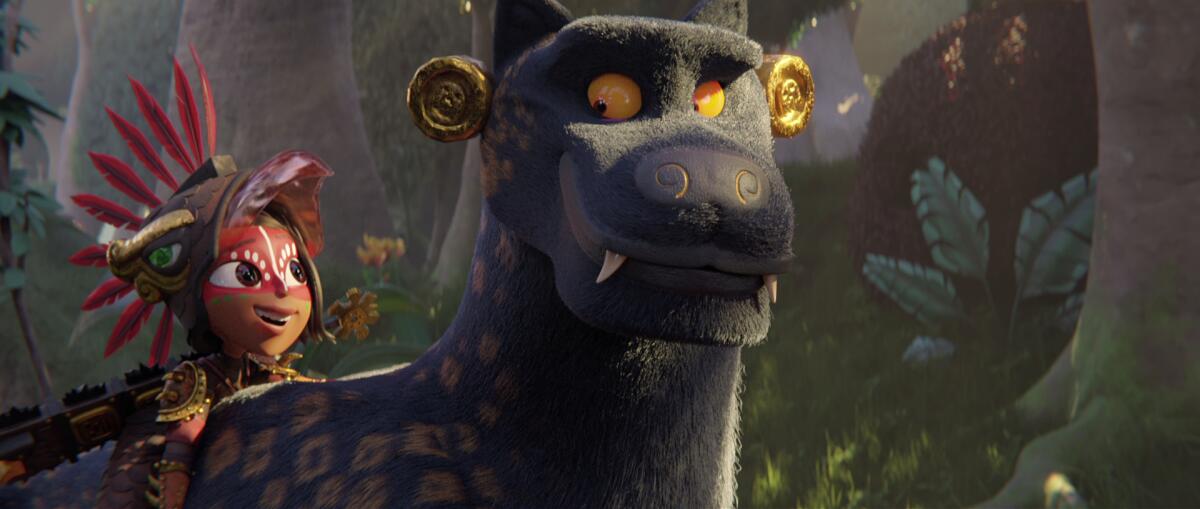
Chiapa and Colmillo
Animals endemic to Mesoamerica populate the environments of the show: turkeys, monarch butterflies (with skull patterns on their wings) and rabbits (invoking “Alice in Wonderland”). Yet the most prominent are felines, more specifically jaguars and pumas. These not only are native to the ecosystem but also tapped into Gutiérrez’s fondness for He-Man and his Battle Cat in the animated series “Masters of the Universe”; his memories of Rufino Tamayo’s mural “Dualidad”; and an image of princesses riding jaguars he saw painted on a lowrider. “One day I asked my dad, ‘Why am I named Jorge? He’s named Jorge, too, and he showed me this painting ‘Saint George and the Dragon.’ He said, ‘Jorges killed dragons. Mijo, one day you’re going to kill dragons.’ I was really little, and that’s when my love for fantasy started and the image of a knight on a horse fighting a dragon got tattooed on my brain.
“When we were getting to this, I was like, ‘I don’t want to bring any horses. This is not that time period.’ That’s how Chiapa, the black jaguar with golden spots, came to serve as the eagle warrior’s ‘noble steed,’” he said. Conversely, its counterpart, a puma named Colmillo, has ties to the darkness via Diego Luna’s character, Zatz. To differentiate between the clawed beasts, production designer Paul Sullivan immersed himself in their anatomy.
The Golden Mountains and the Barbarians
Expanding his sights to include South America, Gutiérrez thought of the valiant warriors in the Golden Mountains, another of the kingdoms on Maya’s voyage, as an amalgamation of nods to the Inca Empire and to John Milius’ “Conan the Barbarian,” a movie from 1982 he’d been mesmerized by as a boy. “When I went to Machu Picchu, I noticed that a lot of Incan warriors were portrayed as having long straight black hair, like Conan’s hair, with the earrings,” the creator said. “Obviously ‘Conan’ is fantasy, but I thought, ‘They had barbarians here.’” He went to write the Barbarians, an alter ego for the Incans, as an imposing but virtuous clan that fought battles only in service of a good cause. Their altruistic brawn is personified in Picchu (voiced by comedian Gabriel Iglesias), the brave and compassionate character who completes Maya’s titular trio of comrades.
An Essential Myth and Sacrifice
Mexico’s coat of arms, present at the center of the country’s flag, sports an eagle killing a snake, which legend says is the sign the gods gave the Aztecs to look for in order to know where to erect Tenochtitlan. Fascinated by this imagery, Gutiérrez made it an intrinsic part of his narrative. “It’s the only flag in the world, that I know of, that has a fight in it. Death is about to happen. It’s basically an action moment frozen. It’s the symbol of Mexico, and it’s everywhere,” he explained. “For anybody who watches ‘Maya’ all the way through, at the end, an eagle kills a snake and saves the world. That was the big myth. We kind of jokingly referenced it visually in the beginning, but then the whole series turns into that story.”
Thinking about myths and prophecies through Maya’s voyage, the director also hoped to challenge the meaning of sacrifice, presenting it not as relinquishing your life involuntarily to appease a deity but as what one gives up for the sake of another or to pursue a dream. “It was an exploration of what it means to sacrifice and to make that choice yourself, not someone else making it for you,” Gutiérrez said. “It was trying to get at the core of what it really means to be a warrior and to make a difference.”
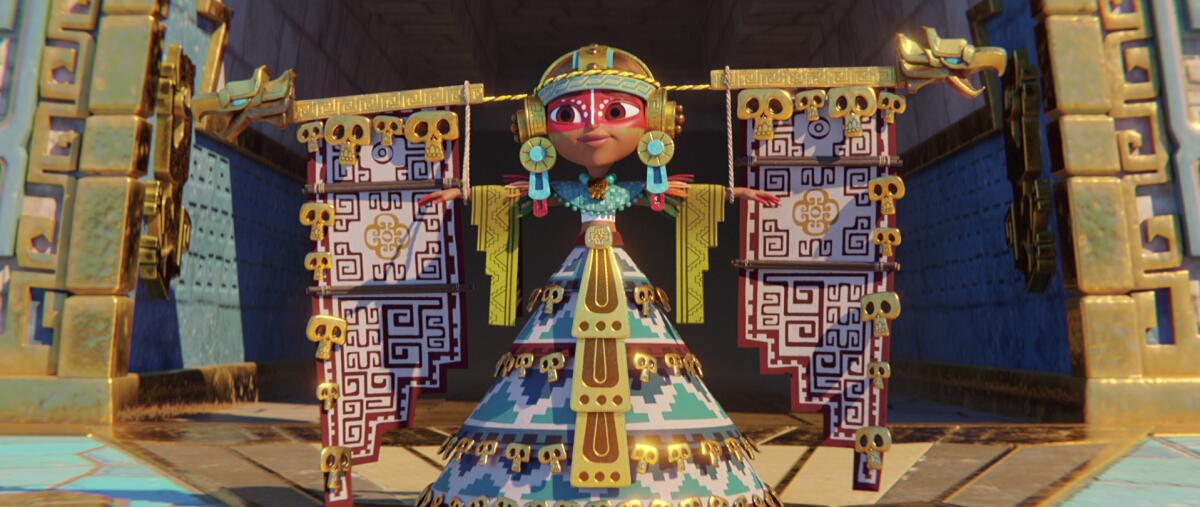
Contemporary Mexico Culture
Raised on a content diet of mainly telenovelas (soap operas) and cartoons, Gutiérrez fused the melodrama of the former and the craft of the other in his young mind. Late ’80s titles such as “Rosa Salvaje” and “Quinceañera” remain the most vivid for him. “There are a lot of telenovela-like moments in this, like a dinner scene between Maya, her two moms and her dad, which we shot and scored to make it feel like a telenovela,” he recalled.
Among the many pop culture references that slipped into this work is the dress Maya wears in episode one, a tip of the hat to the lavish Miss Universe dresses Mexican contestants have worn over the years. By the same token, lucha libre (Mexican professional wrestling) is recurrently present throughout the story, and it’s linked to the mask-making tradition among many of Mexico’s Indigenous peoples. Musically, Gutiérrez asked Oscar-winning composer Gustavo Santaolalla, who has produced several of Mexico’s most notable rock bands, to take inspiration from ska and the genre-defying rhythms of acts like El Gran Silencio. These selections contrast with the inclusion of “Bolom Chon,” a track from the state of Chiapas in the Tzotzil language. Equihua, on the other hand, based the look of goddess Acat (voiced by Chelsea Rendon) on a middle school classmate who wore a beautiful quaff hairdo à la “Mi Vida Loca.” Lastly, as a fan of Alfonso Cuarón’s modern classic “Y Tu Mamá También,” getting Diego Luna and Gael García Bernal to fight each other as animated characters was a point of pride for Gutiérrez. All throughout, “Maya and the Three” marries the contemporary with the primordial.
More to Read
The complete guide to home viewing
Get Screen Gab for everything about the TV shows and streaming movies everyone’s talking about.
You may occasionally receive promotional content from the Los Angeles Times.
